Want to Know Which Vein Treatment in New York Works Best?
Do you suffer from painful varicose veins, leg heaviness, cramping or swelling? We recommend an evaluation for an underlying disease called venous reflux. You don’t have to live with painful veins in your legs, thеrе are many safe, effective and non- ivasive treatment орtіоnѕ available, often covered by major insurances.
Fоrtunаtеlу, our vein clinics in New York offer the latest technology, the treatments dо not involve a long or uncomfortable recovery period, and patients are often back to work the same day. Due to new, minimally-іnvаѕіvе and nearly-painless рrосеdurеѕ, mоѕt vein dіѕеаѕеs can be treated on an outpatient bаѕіѕ.
Some treatments offered at our vein clinics in New York are the following.
Are you trying to ignore your varicose veins or
spider veins because you’re unsure what
treatment entails?
Those veins might be telling you something important about your health. There are several new treatments at our vein clinics in New York that rectify vein damage within minutes. The hard part is choosing the best one, but the procedures themselves are easy for patients. Our vein doctors in New York compiled this explanatory guide so you can stop ignoring those veins and actually make them disappear!
The modern technology used in spider and varicose vein clinics is dramatically different from the techniques of the 1990s. That’s great news for the millions of patients with spider veins, varicose veins, and venous insufficiency who would have required surgery in prior years. FDA approval of radiofrequency ablation (1999), endovenous laser ablation (2002), infusion catheters (2008), sclerotherapy (2010), and vein adhesive (2015) brought minimally invasive, outpatient options to patients for simplified care. But the sheer number of treatments is overwhelming to those who aren’t vein specialists. This guide will help you sort through the options to see what sounds best for you. Then, visit our vein clinics in New York for a proper diagnosis and vein treatment recommendation.
Some patients are so bothered by spider veins or varicose veins that they seek treatment without a proper evaluation. But cosmetic methods aren’t enough if you have vein disease. Many patients have undiagnosed chronic venous insufficiency, which means their veins aren’t pumping blood to the heart efficiently. One or more of their venous valves that help blood ascend, rather than descend, fail, and now blood fills that vein to an overwhelming capacity. The vein dilates to contain the excess pressure. New spider veins trickle out from the overtaxed vein, or varicosities form as blood pools instead of moving through the vein. An NYC vein clinic that doesn’t address this condition only provides temporary results. A vein clinic in New York that doesn’t address this condition only provides temporary results. Our vein doctors in NY state treat vein symptoms and diseases, not just their appearance. Learn more below.
New York Vein Clinic Treatments
Endovenous
Ablation
Also Known As: Thermal tumescent ablation, radiofrequency ablation, laser ablation
Best For: Large varicosities, chronic venous insufficiency, the symptoms of vein disease
What Is an Endovenous Ablation Treatment?
Ablation techniques employ tumescent anesthesia and thermal energy to cauterize a vein’s walls, which forms scar tissue that blocks off the vein. Our vein doctors in New York use this method to address vein malfunction deeper in your leg, as well as the varicose veins you see bulging beneath your skin.
How Do Vein Clinics in New York Administer Endovenous Ablation?
Our vein specialists in New York insert a tiny probe into the vein through the numbed skin just above it. The ablative device generates heat through either soundwaves (radiofrequency) or lasers which are designed to cauterize the vein. Endovenous radiofrequency ablation (also known as ClosureFast, RFA, or RF ablation) and endovenous laser ablation (EVLA or EVLT) serve the same purpose, but RFA uses high frequency soundwaves for heat, whereas EVLA uses light with wavelengths between 800 and 1500 nm to destroy the defective vein. Our vein clinics in NY state have a great deal of experience with both options, but favor radiofrequency because our RFA patients report less discomfort. Before thermally sealing the vein, our doctors surround it with a local tumescent anesthetic that protects the subcutaneous tissue nearby from heat, and also numbs the area to keep you comfortable. Once the vein is closed, it’s no longer viable, so your body absorbs the useless vessel and proper circulation is restored. The ablative process takes 30 minutes or less and you can resume your regular routine immediately.
Pros
A distinct advantage of RFA is that it can treat both venous insufficiency and the surface veins that are caused by it. Another positive attribute is that the vein is treated within your body, rather than being cut out of your body (as with vein stripping surgery). This vastly reduces the risks, complications, and downtime in comparison to surgical vein treatment. Proven safe over the past two decades, RF ablation is commonly covered by insurance and frequently performed at our vein clinics in New York.
Pros Summary:
- 20+ years of proven safety
- Less invasive than vein stripping
- Commonly approved for insurance coverage
- No recovery time involved
Cons
For great results, you have to choose a top vein clinic in New York. Multiple ablation devices are available for these procedures, yielding various outcomes. Check your vein doctor’s credentials and experience with RFA, as well as the device they use, before agreeing to treatment. This is particularly important because of the local tumescent anesthetic injected to protect subcutaneous tissue. If the doctor isn’t practiced in this technique, you’ll be subjected to more discomfort and more injections than necessary. With our RFA specialists, your procedure will be quick, comfortable, and highly effective.
Cons Summary:
- Outcome depends on quality of ablative device
- Vein specialist must be adept at using tumescent anesthetics
Should You Choose Endovenous Ablation?
From safety, efficacy, and affordability perspectives, endovenous ablation is a strong option for most patients. It’s usually covered by insurance and it won’t sideline you during recovery, like surgery will. RFA is our chosen ablation technique, since endovenous lasers are a bit less comfortable.
VenaSeal
Also Known As: Cyanoacrylate glue, medical super glue, vein glue
Best For: Chronic venous insufficiency symptoms (throbbing, heaviness, burning, swelling), spider veins, and varicose veins
What Is a VenaSeal Treatment?
Doctors have been using medical “super glue” for decades, specifically to close wounds and incisions and stop bleeding. Adhesives are frequently used in other vascular procedures, but were just introduced for vein treatment in 2015 by the reputed scientists at Medtronic. Rather than thermally ablating the vein, VenaSeal glues the vein shut with cyanoacrylate adhesive. Although it has a shorter track record than some other vein treatments, medical glue has a long safety record in other clinical procedures.
How Do Vein Clinics in New York Use VenaSeal?
As the name implies, VenaSeal seals damaged veins shut. Our vein clinics in New York start by finding your vein ultrasonically and determining exactly where they want to apply the adhesive. We numb your skin topically and then direct a small catheter to the precise point we want to seal off. The cyanoacrylate glue is released slowly from the catheter, until the vein glues itself together. Once the blood vessel is sealed off, blood starts circulating back toward the heart through viable veins, rather than leaking out of the faulty vein or travelling backward.
Pros
Tumescent anesthesia (used in ablative procedures) can cause mild bruising or swelling, so patients like that VenaSeal doesn’t require it. Cyanoacrylate glue is also advantageous for patients with several defective venous branches, since it can disperse and seal multiple useless pathways at once.
Pros Summary:
- Doesn’t require tumescent anesthesia
- Highly modern technique
- Effective for patients with chronic vein disease
Cons
Other vein treatments have longer track records, since VenaSeal arrived in 2015. An ingredient in the adhesive might be an allergen for some patients. The cyanoacrylate glue hardens and stays in the body once the vein is reabsorbed, which isn’t appealing to everyone. Some insurance companies aren’t covering this treatment yet, since it’s newer.
Cons Summary:
- New technique requiring experience some vein clinics don’t have
- Currently only covered by a few insurance companies
- Adhesive remains in the body and is an allergen for some
Should You Choose VenaSeal?
Have you tried sclerotherapy or ablation before? VenaSeal is a great new option for those whose vein disease recurs. But first, our vein doctors in New York will determine whether an allergic reaction is possible for you and our insurance specialists will ascertain your insurance coverage so you’ll know whether VenaSeal is affordable for you.
Sclerotherapy
Also Known As: STS, cosmetic sclerotherapy. sodium tetradecyl sulfate, saline injections, salt solution injections
Best For: Spider veins and superficial varicose veins
What Is a Sclerotherapy Treatment?
Sclerotherapy is the process of injecting veins with liquid medications designed to aggravate venous walls and make the vein collapse. The result is smaller veins that are lighter in color or even undetectable from the surface of the skin.
How Do Vein Clinics in New York City Perform Sclerotherapy?
Some spider veins are injected with sclerosing solutions after your vein doctor finds them visually. Others require ultrasound imaging to inject, if they’re a bit deeper in your leg. Sclerosants are injected through tiny needles that don’t leave a scar or incision behind. The medicine irritates the interior vein walls so that the lining of the blood vessel swells and closes in on itself, eventually becoming scar tissue. Vein doctors can use a variety of medicines for this procedure, the oldest of which is a highly concentrated salt solution. But our vein clinics in New York use the newest sclerosants that are gentler on patients.
Pros
One reason sclerotherapy is highly regarded is that liquids move through very twisted portions of damaged veins easily, unlike catheters. It’s also one of the faster treatments, in that it doesn’t require anesthesia and can often be injected just by your doctor looking at your vein, if you have superficial spider veins and no vein disease. Sclerotherapy produces better results than skin laser therapy for most patients and is safer for sensitive skin.
Pros Summary:
- Considered the best choice for most spider veins
- One of the fastest procedures
- No anesthesia or recovery time
Cons
Some sclerosants, like morrhuate sodium, are more prone to allergic reaction, since they have ingredients like cod liver oil. Others, like hypertonic saline, are uncomfortable for patients. The safer options currently include sodium tetradecyl sulfate and polidocanol, so it’s important to determine what your doctor uses and how practiced they are in the method. At our vein clinics in New York, the doctors aren’t just vein experts, they’re also Ivy League graduates who are fully accredited, which means they’re trained in the latest research and techniques. Some of the medicines used in sclerotherapy require doctors to mix them with sterile water, which if done correctly, is very safe. But mixed incorrectly, or injected improperly, these medicines have risks like over (or under) dosing and necrosis. Choose our board certified team, recognized by the IAC for the best safety standards.
Cons Summary:
- Certain sclerosants are safer for certain patients
- Complications are possible without a trained vein doctor
Should You Choose Sclerotherapy?
Whether you have spider veins, varicose veins, or recurrent vein disease, sclerotherapy might be exactly what you need. If you’re allergic to any ingredients in tumescent anesthetics or cyanoacrylate glue, sclerotherapy is a strong choice for you. While sclerotherapy treats venous insufficiency, it’s also optimal for those seeking cosmetic vein treatment.
Foam
Sclerotherapy
Also Known As: Foam injections, vein injections
Best For: Most varicose and reticular veins
What Is a Foam Sclerotherapy Treatment?
A foam injection serves the same purpose as a liquid injection, however, the medicine is agitated first for three reasons. One is that foam is more voluminous than liquid, so foam fills larger veins without having to use as much medication. A second reason is that foam displaces the blood in your veins, instead of the blood diluting the medicine, so there’s more contact with the interior lining of the vein when doctors use foam sclerotherapy. Thirdly, foam is easier to see on an ultrasound scan, providing clear confirmation of the medicine’s success.
How Do Vein Clinics In Manhattan Use Foam Sclerotherapy?
Some veins amenable to foam sclerotherapy are found at the surface, while others require ultrasound imaging to locate. Our vein doctors in New York enter the vein first, and then mix the foam, so that it’s as potent as possible when it makes contact with your vein’s interior walls. Mixing foam involves a rapid passage of medication between syringes, which infuses the sclerosing solution with air. This creates bubbles that give the sclerosant a shaving cream-like consistency, which is easily monitored while progressing through your unhealthy blood vessel.
Pros
Foamed sclerosants are impressive at reaching tight spots in tortuous veins. Foam therapy is also a valuable tool for patients whose veins have been treated before.
Pros Summary:
- Superior movement through twisted veins
- Gentle solution for chronic vein disease
Cons
Agitating sclerosants makes them expand and increases their propensity to disperse. So, it’s essential to choose a vein doctor in New York who’s trained in identifying venous connections. If not, you risk medication spreading into veins that don’t need to be treated, damaging healthy blood vessels. If it enters deeper veins, a foamed sclerosant can circulate and cause serious damage.
Cons Summary:
- Extensive experience is non-negotiable for this procedure
- Foam can accidentally enter healthy veins with an untrained provider
Should You Choose Foam Sclerotherapy?
Do you have varicose veins or reticular veins that you wish you couldn’t see beneath your skin? Foam sclerotherapy can treat cosmetic issues, as well as deeper issues like chronic vein disease. If other treatments haven’t resolved your veins, foam sclerotherapy can provide more comprehensive results.
Pre-Mixed
Foam
Sclerotherapy
Also Known As: Varithena, foam sclerotherapy injections
Best For: Large varicosities, venous insufficiency, and related symptoms like restlessness, cramping, and heaviness
What Is a Pre-Mixed Foam Injection?
Pre-mixed foam sclerotherapy is a sterile, injectable version of foam sclerotherapy, in which the foam is primed, sealed, and delivered to the vein clinic ready for treatment. It has a particular advantage over regular foam, in that doctors don’t have to mix it onsite, which reduces the possibility of air embolisms. The compound is optimized with more nitrogen and CO2 so that it accelerates through the vein, deactivating faster, so air doesn’t mistakenly travel to the lungs. It’s potentially safer and definitively more potent than traditional foam injections.
How Do Vein Clinics in New York City Use Pre-Mixed Foam Sclerotherapy?
As with any sclerotherapy treatment, properly identifying the malfunctioning vein and any connecting veins is important before injection. Our vein specialists in New York use ultrasound guidance for veins they can’t see clearly through your skin. The pre-mixed foam is injected with a needle straight from the sterile canister it comes in, rather than being agitated like regular foam. Doctors then track the sclerosant until it deactivates and completes its journey.
Pros
Pre-mixing the foam gives it a higher degree of safety, potency, and efficacy. Patients with recurrent vein disease are advised to consider this technique. Pre-mixed foam sclerotherapy supplants vein surgery for many patients, if a qualified vein specialist administers it.
Pros Summary:
- Considerably more powerful than many treatments
- Highly effective for avoiding surgery
- A top option for chronic vein disease
Cons
The solution used in pre-mixed foam sclerotherapy is markedly more powerful than other solutions, so choosing a trained vein specialist is paramount. This method is quite expensive, and some patients aren’t granted insurance coverage, so check with our team to see what it will cost.
Cons Summary:
- Vein doctor experience is crucial
- It’s expensive and some insurance plans don’t include it
Should You Choose Pre-Mixed Foam Sclerotherapy?
Patients who are covered by insurance for this procedure should definitely consider it. It outperforms surgery with minimally invasive tactics for many patients with varicose veins and vein diseases that recur.
ClariVein
Also Known As: MOCA, mechanochemical ablation
Best For: Recurrent vein disease, chronic venous insufficiency, varicose veins, and related symptoms
What Is a ClariVein Procedure?
With the ClariVein method, vein doctors ablate a troubled vein both mechanically and chemically (mechanochemical or MOCA) with one device. The ClariVein catheter rotates inside the blood vessel, which traumatizes its structure. The catheter also disseminates a chemical throughout the vein, which aggravates the interior lining further to systematically destroy the problematic vein.
How Do Vein Doctors in New York Administer ClariVein?
Our NY vein doctors find the vein ultrasonographically or by sight, depending on its depth. After cleansing and numbing your skin, they insert the catheter tip into the vein and activate it so that it rotates against the vein’s walls and disperses the sclerosant throughout its interior. The catheter can be guided throughout the length of the vein if needed to thoroughly treat the issue. The combination of ablative tactics helps prevent vein damage from recurring.
Pros
Since it’s not a thermal procedure, patients don’t need tumescent anesthesia around their vein, like with endovenous ablation. It also doesn’t use adhesives, so there are no solid compounds left behind, like with VenaSeal. It uses a dual approach for thorough results.
Pros Summary:
- No thermal energy, so, no tumescent anesthesia
- No adhesives, so, no implanted substance
Cons
Sometimes complications occur with ClariVein when a doctor can’t easily move the catheter through a valve in the vein. This can be very uncomfortable. Also, insurance companies don’t always pay for ClariVein.
Cons Summary:
- Insurance might not pay for ClariVein
- Discomfort possible when passing through venous valves
Should You Choose ClariVein?
Are you prone to allergic reactions or anaphylaxis? Are you opposed to a hardened substance in your body? If so, you might prefer ClariVein over RFA, EVLA, or VenaSeal procedures. Our insurance team will determine if you’re eligible for coverage, so you can decide if ClariVein is right for you.
New York Vein Clinic Surgery
Also Known As: Vein stripping surgery, phlebectomy, surgical vein removal
Best For: The largest, most complicated varicose veins
What Is Vein Stripping Surgery?
A typical vein surgery requires deep incisions, often in the groin and knee, to access deeper diseased veins, as well as smaller incisions to treat the visible veins. The vein is surgically extracted with a number of tools and the patient’s larger incisions are closed with sutures or stitches.
How Do NY Vein Clinics Conduct Vein Surgery?
The veins are identified with ultrasound machines, and then the patient is given general (sometimes spinal) anesthesia and wheeled into surgery. A vein surgeon will cut down to reach the vein, commonly at the groin and knee, then tie off (ligate) the top of the saphenous vein to stop bleeding, and strip the vein out of the patient by inserting a wire into it or using a hook to pull it loose. Smaller incisions (sometimes several) might be made to treat the veins closer to the skin’s surface. The primary incisions at the knee and groin are stitched closed and the patient might stay overnight in the hospital or leave after observation and waking from anesthesia.
Pros
Some patient’s varicose veins have dangerous blood clots or are unusually large and tortuous, so surgery is a safer choice for them.
Pros Summary:
- While surgery is unnecessary for most, a few patients do require it
Cons
With so many minimally invasive, modern options to choose from, surgery is considered outdated and unadvised for most vein conditions. It’s the most time-intensive and risk-prone procedure, so patients should consider it a last resort. Reputable vein clinics in New York recommend gentler solutions that work better than surgery whenever possible.
Cons Summary:
- For most patients, surgery is not necessary or advised • New treatments work better with less risk and downtime
Should You Choose Vein Surgery?
Only a select group of patients truly require vein stripping. That includes certain people with blood clots or failed treatment attempts on complicated, larger veins. Vein surgery for smaller veins, superficial spider veins, and patients without vein disease is almost never required.
What questions do you have about the vein treatments we’ve described? Our board-certified vein specialists in New York love providing clarity on the many ways we treat vein issues. Call our vein clinics in Midtown or the Financial District to gain further insight on our acclaimed vein treatments.
How Do You Choose a Vein Clinic in New York?
Vein treatment isn’t something you should choose on your own. Talk to a certified vein specialist at an accredited vein clinic in New York to find your best fit. The top doctors will even customize treatments to give you flawless results. Here are five things to consider when looking for a vein clinic in New York City.
Your vein treatment is precisely what you need:
No two vein treatments are equally right for you. Some veins are treated cosmetically, while others involve chronic disease. For instance, spider veins rarely require pre-mixed foam sclerotherapy, whereas varicose veins rarely respond to topical laser treatments. Some patients require a combination of tactics to properly treat their spider or varicose veins. Choose our vein doctors in New York for a customized treatment that’s exactly what you need.
Your vein doctor spends time explaining treatment:
Have you ever left a doctor’s appointment with unanswered questions? Unfortunately, it happens rather often. But our vein clinics in New York specialize in listening to patients and deciphering what they really want to know. Our vein doctors frequently write about, lecture about, and teach other doctors about venous medicine. We use those skills to explain everything discernibly to our patients.
Your vein doctor uses ultrasound guidance:
Most modern vein treatments now utilize ultrasound technology for steps like locating deep veins, positioning catheters, and dispensing vein adhesives. Choose a vein clinic in New York whose doctors operate these devices, rather than one whose ultrasound assistant handles the device.
Your vein specialist conducts a thorough analysis:
Some varicose and spider vein clinics only offer topical injections or lasers to diminish the appearance of surface veins. The problem is, most patients’ vein damage stems from venous insufficiency, which requires different treatment. If you don’t want unsightly veins to keep showing up, choose a vein clinic in New York that takes a holistic approach to vascular health. Our vein clinics in Manhattan treat visibility, symptoms, and diseases of veins, often with a single device.
Our NJ vein doctors are world-class physicians.
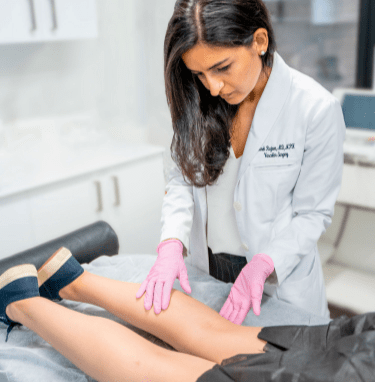
Our treatment plans always incorporate your input.
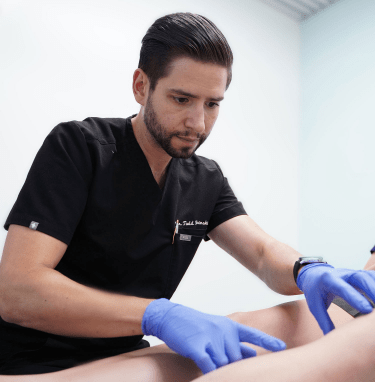
Our vein
centers offer
state-of-the-art care.
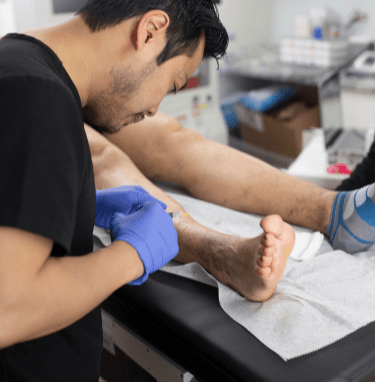
*New clinic locations might be in the approval process at the time of publication.
Our board-certified vein doctors are distinctly trained.
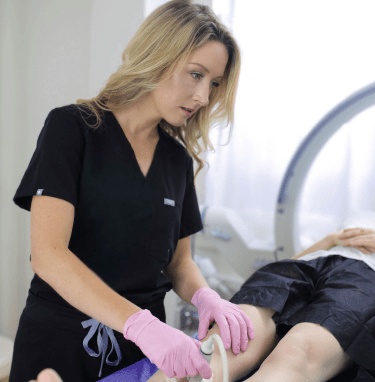
Our 5-star
reviews speak for themselves.
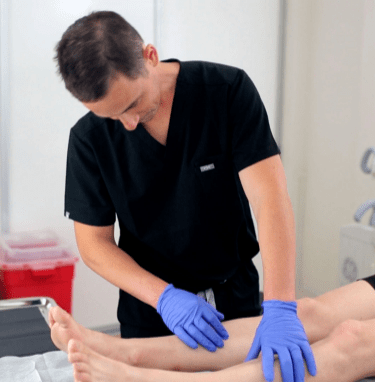
Do you see bulging veins, itchy patches, discoloration, or ulcers on your skin? Are your legs throbbing, achy, heavy, swollen, restless, or itchy? You don’t have to tolerate the appearance and symptoms of defective veins. Visit our award-winning vein clinics in New York for an assessment. With several convenient locations in the Big Apple, spider vein and varicose vein treatment is quicker, gentler, and easier than you think.

Coverage Checker:
Contact us
Call us
Speak with one of our team members right away to get answers about insurance coverage, scheduling an appointment, and our vein clinic locations (332) 263-4887.
Book online
Request an appointment at any of our New York Vein Clinics by visiting our Book Appointment page. Before your visit, we offer free insurance verification.
Get directions
Learn how to easily get to the NY Vein clinic nearest you.